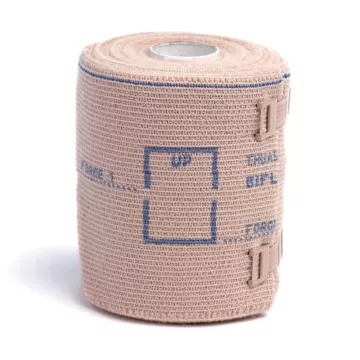
Compression bandages are a valuable tool in the management and treatment of a variety of medical conditions related to venous circulation. Its effectiveness depends on proper use, adapted to individual needs and supervised by professionals. By integrating this device into your care routine, you actively contribute to your venous health and overall well-being.
What is a compression band and how does it work?
A compression band is a medical device designed to exert controlled pressure on a specific part of the body. Used primarily in treatment for varicose veins, deep vein thrombosis (DVT), and after surgical procedures, they help improve blood circulation, reduce edema and prevent blood clots. By applying graduated pressure - stronger at the ankle and decreasing towards the upper leg - it supports venous return to the heart and reduces venous stasis.
Why and when use a compression bandage?
The use of a compression band is indicated in a number of situations: prevention and treatment of chronic venous disease, management of post-thrombotic symptoms, post-operative support, and in some cases, as support during physical activities to reduce the risk of injury and improve muscle recovery. It is essential to consult a healthcare professional to determine the appropriate timing and correct use of this device for your specific condition.
How to choose the right size and type of compression bandage?
Selecting the right compression bandage depends on several factors: size (measured in centimeters around the area to be compressed), level of compression required (measured in mmHg, millimeters of mercury), and type (elastic, inelastic, adhesive, etc.). It is crucial to follow the recommendations of a healthcare professional to ensure maximum effectiveness and avoid any risks associated with incorrect use.
How do I apply a compression bandage?
To reap the full benefits of a compression bandage, there are a few practical tips to follow:
What are the possible side effects and how can they be managed?
Although generally safe when used correctly, compression bands can cause side effects such as skin irritation, numbness or pain if over-tightened. It is essential to monitor the condition of the skin and blood circulation in the compressed area, and to consult a healthcare professional immediately in the event of discomfort or unusual symptoms.
How do I care for and wash my compression bandage?
To ensure the longevity and effectiveness of your compression band, proper care is essential. We recommend hand-washing or machine-washing (if indicated by the manufacturer) at a temperature not exceeding 30°C, using a mild detergent without fabric softener. Avoid wringing the belt out; squeeze gently. Let dry in the open air, away from sources of direct heat such as radiators or direct sunlight. Never use a tumble dryer. Finally, check the condition of the band regularly for any wear or loss of elasticity, and replace it according to the manufacturer's recommendations.
Can I sleep in a compression bandage?
In general, it is not recommended to wear a compression band during sleep, unless your healthcare professional advises otherwise. At night, there is often less need for compression, as lying down naturally encourages venous circulation towards the heart. However, in certain specific cases, such as advanced venous disease or precise post-operative instructions, night-time wear may be advisable under medical supervision.
Is a compression band effective against varicose veins?
Yes, compression bands are an effective way of managing and preventing varicose veins, as they help to reduce pressure in the leg veins, thereby promoting better blood circulation. Wearing compression bands regularly, particularly in the early stages of varicose veins or for those at risk due to genetic or lifestyle factors, can help slow their progression and relieve associated symptoms such as pain, swelling and heaviness in the legs.
What's the difference between a compression bandage and a compression stocking?
The main difference between a compression bandage and a compression stocking lies in the way they are applied and used. A compression band is a flexible device that can be adjusted to suit the size and shape of the limb, providing customizable compression. They are particularly useful for irregular body shapes, or in cases where a very specific fit is required. Compression stockings, on the other hand, are ready-to-wear garments offering fixed graduated compression, more practical for everyday use. Stockings are often used for the prevention and long-term treatment of venous disorders.
Are compression bands suitable for all types of physical activity?
Compression bands can be beneficial for a variety of physical activities, particularly those that put intense strain on the legs, such as running, cycling and certain team sports. They help support muscles, reduce vibration and improve blood circulation, which can contribute to better performance and faster recovery. However, it's important to choose the right type and level of compression for your activity, and to consult a healthcare professional or sports specialist for personalized advice, to avoid any risk of excessive or inappropriate compression.